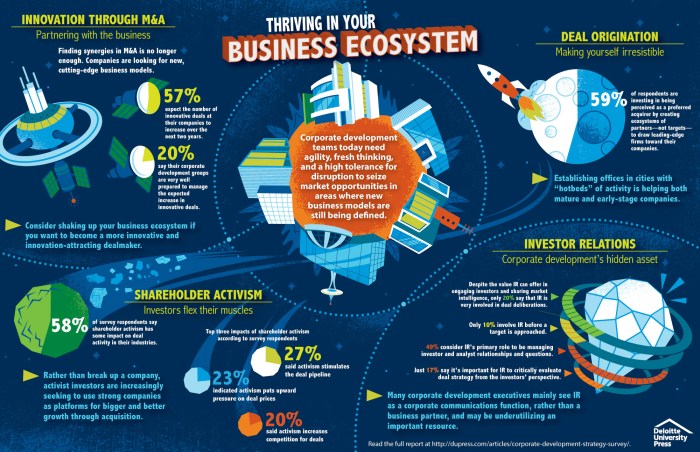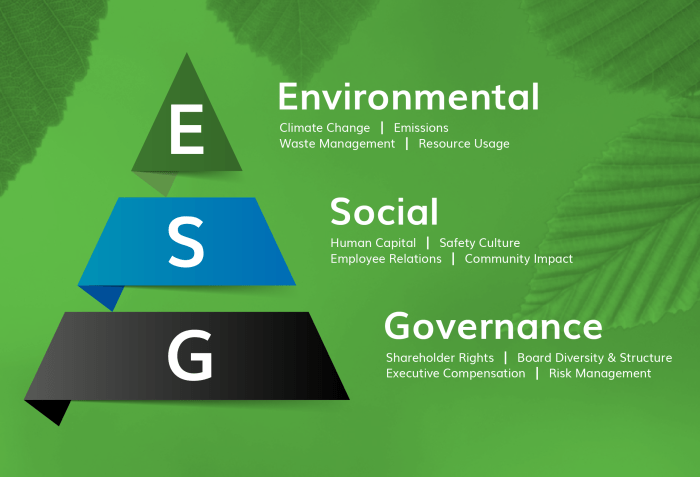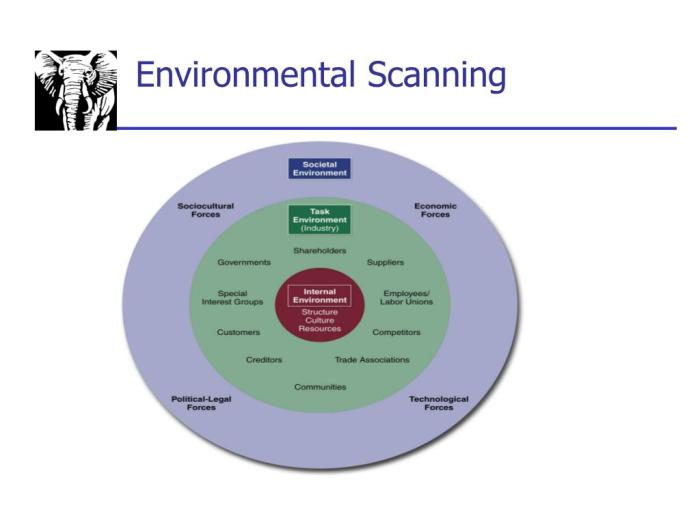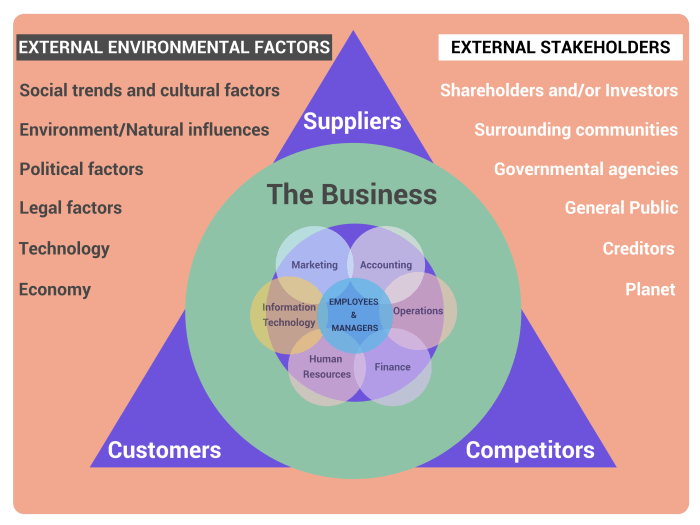
Business environment and corporate strategy sets the stage for this enthralling narrative, offering readers a glimpse into a story that is rich in detail with entertaining interactive style and brimming with originality from the outset.
Embark on a journey through the intricate web of external and internal factors that shape corporate strategy, as we uncover the secrets to thriving in a competitive business environment.
Business Environment
The business environment refers to the external factors that impact the operations and performance of a company. It includes economic, social, political, technological, and legal conditions that influence business activities.
Importance of Understanding the Business Environment for Strategic Planning
Strategic planning involves setting goals and determining the best ways to achieve them. Understanding the business environment is crucial for strategic planning as it helps companies anticipate changes, identify opportunities, and mitigate risks.
- It allows companies to align their strategies with external trends and developments.
- By analyzing the business environment, companies can make informed decisions and adapt to market changes effectively.
- Understanding the business environment helps companies stay competitive and innovative in their industry.
Key Elements of the Business Environment
The key elements that constitute the business environment include:
- Economic Factors: such as inflation rates, exchange rates, and economic growth.
- Political Factors: including government policies, regulations, and stability.
- Social Factors: such as demographics, cultural trends, and consumer behavior.
- Technological Factors: advancements in technology that impact operations and competitiveness.
- Legal Factors: laws and regulations that companies must comply with.
Impact of Changes in the Business Environment on Corporate Strategy
Changes in the business environment can have a significant impact on corporate strategy:
For example, a shift in consumer preferences towards sustainable products can prompt a company to adjust its product offerings and marketing strategies to meet the demand.
- Technological advancements can create new opportunities for companies to streamline operations and improve efficiency.
- Changes in government regulations can require companies to modify their practices to ensure compliance.
- Economic downturns can force companies to reevaluate their cost structures and prioritize investments.
External Factors

External factors play a crucial role in shaping the business environment and influencing corporate strategy. These factors can have a significant impact on a company’s operations, decision-making, and overall success. Let’s explore how political, economic, social, and cultural factors affect businesses.
Political Factors Influence
Political factors have a direct influence on corporate strategy as government policies and regulations can create opportunities or pose challenges for businesses. For example, changes in taxation laws, trade agreements, or government stability can impact a company’s operations and profitability. Companies must closely monitor political developments to adapt their strategies accordingly.
Economic Conditions Impact
Economic conditions, such as inflation, interest rates, and market trends, can greatly influence business decision-making. For instance, during a recession, businesses may need to adjust their pricing strategies, reduce costs, or diversify their product offerings to stay competitive. Understanding the economic landscape is essential for businesses to make informed decisions and navigate market fluctuations.
Social and Cultural Factors Affect
Social and cultural factors also play a significant role in shaping the business environment. Consumer preferences, societal values, and demographic trends can impact a company’s marketing strategies and product development. For instance, companies that fail to adapt to changing cultural norms or consumer demands may struggle to retain customers and remain relevant in the market. It is essential for businesses to stay attuned to social and cultural shifts to effectively engage their target audience and drive growth.
Internal Factors

Internal factors play a crucial role in shaping corporate strategy and overall business success. From organizational structure to company culture, these factors have a significant impact on the decision-making process and the ability to achieve strategic goals.
Organizational Structure and Strategic Decisions
Organizational structure refers to how tasks, roles, and responsibilities are allocated within a company. It directly influences the decision-making process and overall strategy implementation. A centralized structure, for example, may lead to more top-down decision-making, while a decentralized structure allows for greater autonomy and flexibility at lower levels. Companies must carefully consider their organizational structure when developing and implementing strategic plans to ensure alignment and efficiency.
- Centralized structure: Hierarchical decision-making, clear chain of command, efficient communication.
- Decentralized structure: Empowerment of employees, quick response to market changes, innovation and creativity.
- Matrix structure: Combination of functional and divisional structures, balanced focus on products and functions.
It is essential for companies to align their organizational structure with their strategic objectives to ensure effective implementation and success.
Company Culture and Business Environment
Company culture refers to the shared values, beliefs, and practices within an organization. It plays a vital role in shaping the business environment and influencing employee behavior, decision-making, and overall performance. A strong and positive company culture can drive innovation, collaboration, and employee engagement, leading to a competitive advantage in the market.
- Innovative culture: Encourages experimentation, risk-taking, and creativity.
- Collaborative culture: Emphasizes teamwork, communication, and shared goals.
- Customer-centric culture: Focuses on delivering value and exceptional service to customers.
Resources and Capabilities in Corporate Strategy
Resources and capabilities represent the internal strengths and assets of a company that can be leveraged to achieve competitive advantage and strategic success. From financial resources to human capital and technological capabilities, companies must strategically allocate and develop their resources to support their strategic goals and objectives.
- Financial resources: Capital investment, budget allocation, financial stability.
- Human capital: Skilled workforce, talent development, employee retention.
- Technological capabilities: Innovation, digital transformation, technological infrastructure.
Competitive Landscape
In a business environment, the competitive landscape refers to the overall structure of competition that exists in the industry. Understanding the competitive landscape is crucial for developing effective corporate strategies.Competitors can include both direct competitors who offer similar products or services, as well as indirect competitors who provide alternatives that satisfy the same customer needs. Analyzing competitors involves gathering information on their strengths, weaknesses, strategies, and market positioning.
Analyzing Competitors
- Conduct a SWOT analysis to identify the strengths, weaknesses, opportunities, and threats of each competitor.
- Monitor competitors’ marketing strategies, pricing tactics, product innovations, and customer feedback.
- Assess competitors’ financial performance, market share, and growth trajectory.
- Utilize competitive intelligence tools and techniques to gather data and analyze competitor behavior.
Competitive Advantage
Competitive advantage is the unique set of attributes or capabilities that enable a company to outperform its rivals. It is essential for sustainable success in a competitive market environment.
Having a competitive advantage allows a company to differentiate its products or services, achieve higher profitability, and attract more customers.
Market Dynamics and Strategic Decisions
- Market dynamics such as changes in consumer preferences, technological advancements, regulatory shifts, and competitive actions can significantly impact corporate strategic decisions.
- Companies need to adapt their strategies in response to market trends, competitive threats, and external forces to maintain a competitive edge.
- Examples include entering new markets, launching innovative products, forming strategic partnerships, or acquiring competitors to strengthen market position.
Conclusion
As we conclude our exploration of business environment and corporate strategy, remember that understanding these dynamics is key to unlocking success in the ever-evolving world of business. Embrace change, leverage resources, and navigate the business landscape with confidence to achieve your strategic goals.
FAQ Corner
How does the business environment impact corporate strategy?
The business environment influences strategic decision-making by presenting challenges and opportunities that shape the direction of a company’s strategy.
What role do external factors play in corporate strategy?
External factors, such as political, economic, and social conditions, can significantly impact how a company formulates and executes its strategic plans.
Why is it important to analyze the competitive landscape?
Understanding the competitive landscape helps businesses identify threats, capitalize on strengths, and stay ahead of the competition in the market.







